Workstation Optimization Project Presented at Lunch and Learn Event
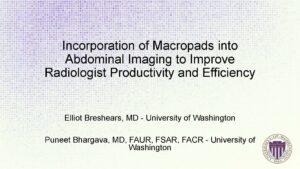 Elliot Breshears, M.D., PGY-5, presented “Incorporation of Macropads into Abdominal Imaging to Improve Radiologist Productivity and Efficiency” at the Sixth Annual Lunch and Learn Event on May 6, 2023. A summary of the project follows.
Elliot Breshears, M.D., PGY-5, presented “Incorporation of Macropads into Abdominal Imaging to Improve Radiologist Productivity and Efficiency” at the Sixth Annual Lunch and Learn Event on May 6, 2023. A summary of the project follows.
Increasing exam volumes and other demands on radiologists’ time highlight the importance for radiologists to identify ways to optimize productivity and efficiency. Elliot’s focus has been on workstation optimization, specifically on a peripheral device called a macropad.
The number of clicks as well as computer navigation correlated with reading a study (see Liver Reporting Data System image below) typically requires eight keystrokes and 50 cm of mouse navigation; with continued use these functions add up. That is where macropads come into play.
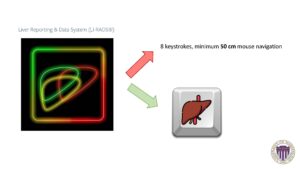
They are composed of input buttons that can be programmed to perform targeted tasks such as opening a program. One such macropad is called a Stream Deck. However, many of the Stream Deck capabilities are not supported by the team’s software or institutions that have restrictions on software connections, which is becoming increasingly common.
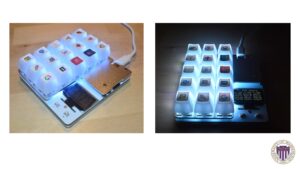 After reviewing those available on the market, the duckyPad was selected, the only device identified to provide an acceptable level of functionality. After initial programming on a non-restricted computer, onboard memory in the form of a microSD card allows duckyPad to be used on workstations without further installation of software or drivers. It was programmed to open on frequently accessed online resources.
After reviewing those available on the market, the duckyPad was selected, the only device identified to provide an acceptable level of functionality. After initial programming on a non-restricted computer, onboard memory in the form of a microSD card allows duckyPad to be used on workstations without further installation of software or drivers. It was programmed to open on frequently accessed online resources.
Initially, 15 resources were mapped; however, multiple commands can be assigned to each key to enable toggling between profiles and switching the functionality of each key. Stickers were created to identify the resource associated with the key.
There are a number of websites that allow the uploading of customized PDF documents to a URL. A PDF document containing all of the flow charts from JACR White Papers on Incidental Findings was compiled into a single PDF and mapped to one of the keys.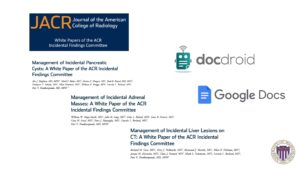
Assembly: All parts were included and assembly time was 30 minutes. Custom vinyl stickers were applied and it was ready for programming. These were programmed using the duckyPad software and 15 keys were assigned abbreviated names. Each key was programmed to open one of the online resources.
The keys were programmed to open the task bar and input the URL within a new tab of a web browser. Delays were input to help the program catch up to the URL, as it loaded very quickly. The plug and play nature of the device made it ready to use after programming!
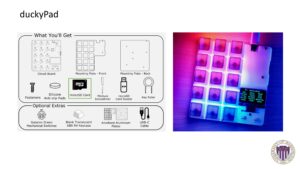 For frequently accessed resources, for the amount of time it takes to search for articles and open links, it is efficient for accessing resources. The duckyPad was replicated and three devices were circulated to abdominal reading rooms at separate sites.
For frequently accessed resources, for the amount of time it takes to search for articles and open links, it is efficient for accessing resources. The duckyPad was replicated and three devices were circulated to abdominal reading rooms at separate sites.
Overall feedback from the radiologists was positive. It was reported to be intuitive and pleasing to use and demonstrated the potential for reducing both mental effort and time to perform repetitive tasks.
One additional duckyPad was also customized by Elliot for use on call for a number of shifts at HMC and it was helpful when trying to juggle phone calls, reading studies, and looking up resources quickly. It demonstrated the ability of this device to be modified for any imaging section, not just abdominal imaging.
Despite successful implementation, it does have several limitations that may prevent widespread use. Assembly would be time consuming, and devices are only shipping from the UK. The duckyPad is limited by the design of its switches, which firmly rest within the front plate, but are not secured by metal or glue. Potential loosening of the switches with time could require troubleshooting that would negate the time-saving benefits of the device.
The device is also limited by its programming language, duckyScript. The team was able to program it to open the websites and perform basic functions, but in order to perform a task that is more complex to be associated with a macro would not be possible with the limitations of the duckyScript. The duckyPad circumvents the obstacles of software requirements for macropad use, but the limitations of the device would curtail its widespread use.
Elliot’s experience is that the incorporation of macropads into daily practice for radiologists is best achieved with pre-assembled pads that require software support. Going forward the next goal with this project is to collaborate with IT to facilitate the installation of software that is required to support some of these devices such as the Stream Deck.
The team would then like to create a standardized profile of resources, potentially one for abdominal imaging, residents, and neuroradiology, and store those resources on a server or online on a platform such as OneDrive. They would then be able to pull that profile onto a Stream Deck device and standardize profiles across the entire department.
This would be a much more efficient way of implementing macropads across the department. Special thanks to the Rohrmann Endowment which made funding for this project possible. Elliot was able to have an entire month of half-days in the afternoon when he was able to develop and work on the device.
Elliot also thanked his mentor, Dr. Puneet Bhargava, for all his guidance.
If you’d like to learn more about how to set up your own macropad and personalize it, read this article on ScienceDirect.